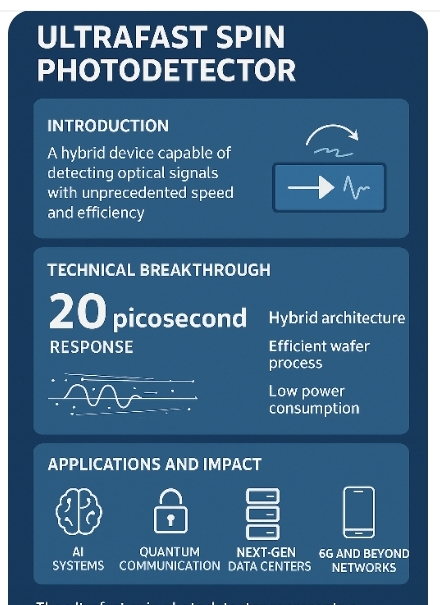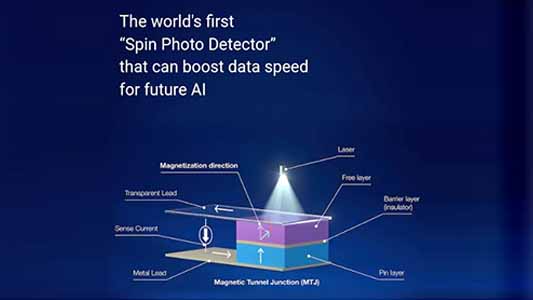Traditional electronic interconnects struggle with bandwidth, power consumption, and latency when handling the massive data flows required by modern AI models. To overcome these bottlenecks, researchers have turned to photonics—the science of using light for data transmission. In 2025, TDK Corporation announced the development of an ultrafast spin photodetector, a hybrid device capable of detecting optical signals with unprecedented speed and efficiency, marking one of the most important advances in electronic–photonic integration.
The Concept of Spin Photodetection
Unlike conventional photodetectors that simply convert light into electrical signals, spin photodetectors exploit the spin properties of electrons. Spin, a fundamental quantum property, enables encoding and processing of information in addition to charge. By coupling optical photons with electron spin states, spin photodetectors can achieve:
▪Faster signal response times
▪Reduced power losses
▪Improved sensitivity across a broad wavelength spectrum
This dual exploitation of light and spintronics makes them highly promising for bridging the gap between optical communication and electronic data processing.
Technical Breakthrough: 20 Picosecond Response
The TDK ultrafast spin photodetector has achieved a record-breaking response time of 20 picoseconds (20 trillionths of a second). For comparison, traditional silicon-based photodetectors typically operate in the nanosecond (10⁻⁹ s) range, making this new device nearly 100× faster.

Figure . How ultra fast photo detector works ( Image credit- tdk.com)
Key Technical Features:
▪Hybrid architecture: Combines optical, electronic, and magnetic elements.
▪Efficient wafer process: Designed for manufacturability on semiconductor wafers without overly complex fabrication steps.
▪Low power consumption: Operates with significantly reduced thermal losses compared to conventional devices.
▪Broad applications: Suitable for optical interconnects in AI accelerators, quantum communication systems, and 6G networks.
Applications and Impact
1. Artificial Intelligence Systems
Large AI models require massive parallel data transfer between GPUs, TPUs, and memory banks. Optical interconnects powered by ultrafast spin photodetectors could dramatically reduce latency while cutting energy costs. This addresses one of the biggest bottlenecks in generative AI scaling.
2. Quantum Communication
Because the detector inherently interacts with spin states, it could integrate seamlessly with quantum information protocols, enabling faster and more reliable transfer of quantum data.
3. Next-Generation Data Centers
Data centers consume enormous amounts of power. Incorporating spin photodetectors in optical fiber interconnects could slash energy usage while boosting throughput, creating greener and more sustainable computing infrastructure.
4. 6G and Beyond Networks
With response speeds in the tens of picoseconds, these devices could underpin future 6G wireless backhaul systems, where ultralow latency and high bandwidth are mandatory.

A Symphony of Speed and Finesse
The implications of this shift are profound. The most immediate advantage is breathtaking speed. By leveraging the ultrafast transfer of spin angular momentum, rather than waiting for charges to physically separate, these devices can operate at terahertz frequencies—orders of magnitude faster than the fastest conventional photodetectors. This speed is matched by a new tier of energy efficiency, as the direct generation of a spin current minimizes wasteful heat dissipation.
But perhaps the most transformative aspect is the inherent functionality. This single device acts as its own high-speed, built-in logic gate. It can instantly distinguish between different spins of light, a capability that could revolutionize secure optical communication. Data could be encoded not just in the ones and zeros of light pulses, but in their spin states, dramatically increasing bandwidth and enabling new forms of cryptography. In quantum computing, such a detector could be the essential readout tool for quantum bits (qubits) that store information in spin states. Furthermore, this technology provides a powerful new lens for fundamental science, allowing researchers to probe the dynamics of spin in materials and chemical reactions with unprecedented temporal resolution.
Lighting the Path to a Spintronic Future
The journey from laboratory marvel to integrated circuit is underway, with challenges in material design and integration at scale still to be conquered. Yet, the trajectory is clear. The ultrafast spin photodetector is more than an incremental improvement; it is a gateway technology. It represents the first crucial step in moving from an electronics and photonics dominated by charge, to a new paradigm of spintronics—where information is processed and stored using the spin of the electron.
It is a technology that promises to let our machines not just see the light, but to finally understand its deepest language, enabling a future of computation, communication, and discovery operating at the true speed of thought.
References:1)chatGPT and Deepseek
About the author : Vinayak. Ramachandra. Adkoli, B. E. in Industrial Production and served as lecturer in three different polytechnics for 10 years. I am also a freelance writer and cartoonist.












